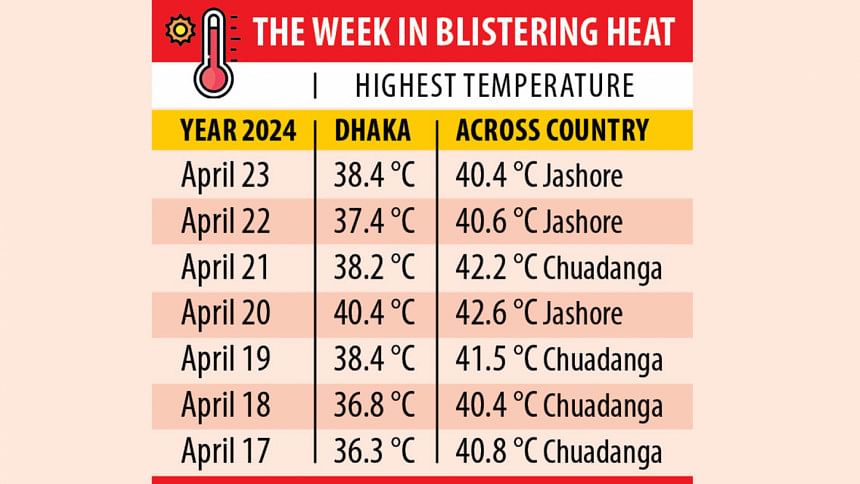An April way hotter than 30-year average

Over the last seven days, temperatures in the capital and other heatwave-affected places have been consistently four to five degrees Celsius higher than the corresponding seven days in the last 30 years, according to Met department data.
Dhaka's average temperature on April 23 for three decades has been 33.6 degrees Celsius. But yesterday, mercury rose to 38.4C.
As the country sees blistering temperatures of 42C or more, high levels of humidity are making it particularly uncomfortable for the people.
"Due to humidity, it feels like the weather is four to five degrees hotter," said AKM Nazmul Hoque, a meteorologist at the Bangladesh Meteorologist Department.
Experts say the average temperature of a place on a given date is calculated by making an average of the temperature on that date over 30 years.
April 22's average temperature in Dhaka city was 33.7C. But on Monday, the temperature hit 37.8C, a rise of over 4C.
On the same date, the country's highest 40.6C was recorded in Jashore, Khulna and Chuadanga, which is way more than the average -- 35.7C, 34.7C, and 36C in the districts respectively.
Yesterday's temperatures in Khulna was 5.9C higher than the average, in Jashore 4.9C higher, and in Chuadanga 4.6C higher.
This year's highest so far has been 42.6C in Chuadanga on April 21. That day's average in the district is 37.5C.
The Met department's heat alert for 72 hours ends today. Officials say the heatwave may persist until the end of this month.
Experts say the heatwave is generated by El Nino which is currently impacting the South and South Eastern regions and it will continue to sear the country till the end of this month.
"The temperature is rising as the El Niño flips to La Niña and it could be the hottest year on record," said Rashed Chowdhury, senior global futures scientist at Julie Ann Wrigley Global Futures Laboratory.
When El Niño is in play, the trade winds weaken, and the surface water in the equatorial Pacific becomes warmer and east winds blow weaker than normal, said Rashed Chowdhury.
He also said, the ocean measurements currently show warm surface temperatures in the Pacific. However, El Niño is likely to give way soon, ushering in a quick switch to its opposite atmospheric and ocean pattern, La Niña.
El Niño and La Niña are climate patterns in the Pacific Ocean that can affect weather worldwide.

 For all latest news, follow The Daily Star's Google News channel.
For all latest news, follow The Daily Star's Google News channel. 










Comments